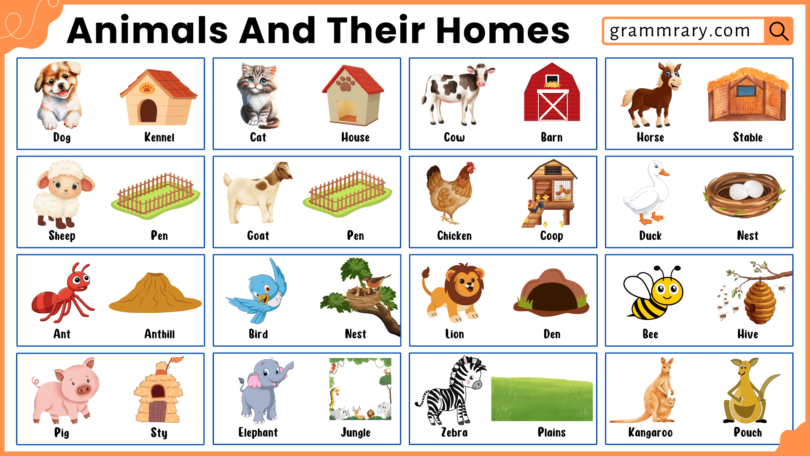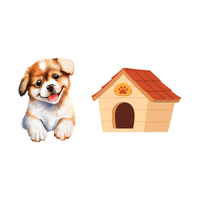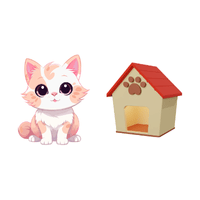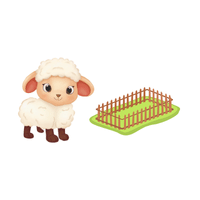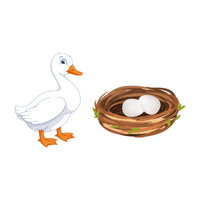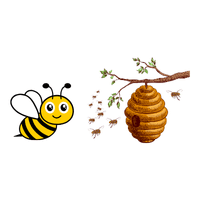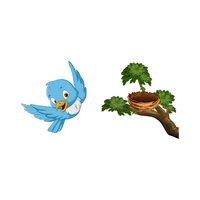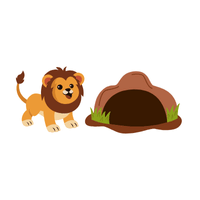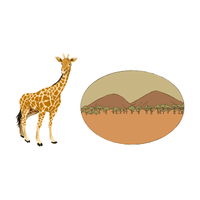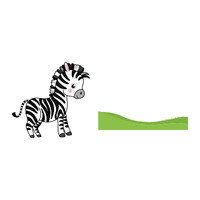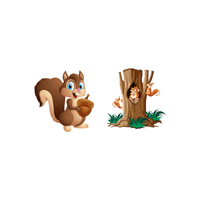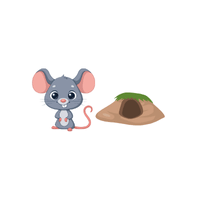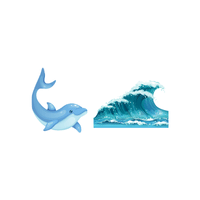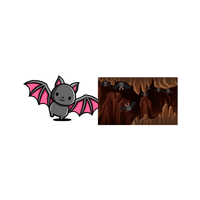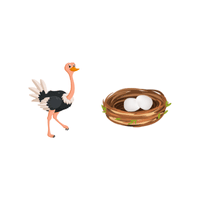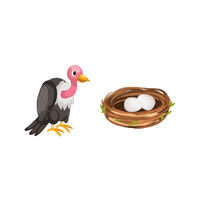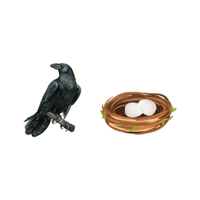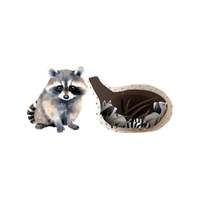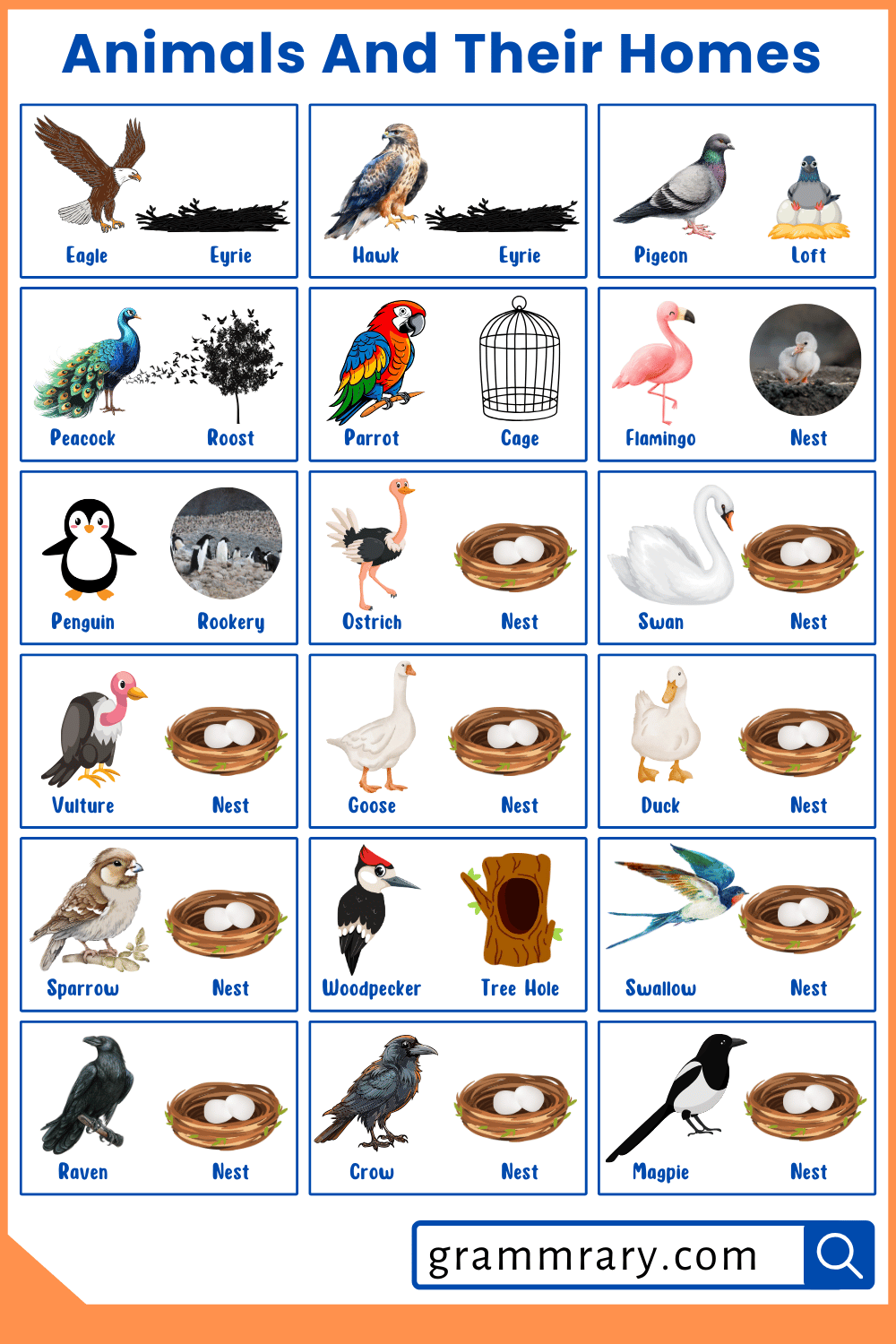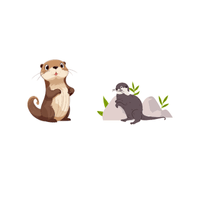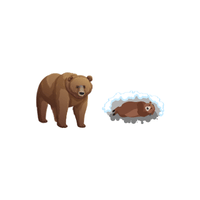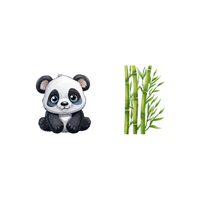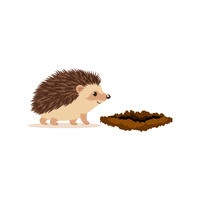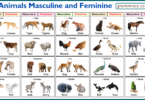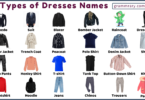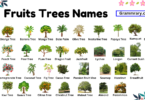Learning the homes names of different animals is an amazing way increase your vocabulary and knowledge about animals homes. For example, a lion’s home is called a den, and birds live in nests in trees. Rabbits dig burrows, and bees build hives. Horses stay in stables, and dogs have kennels. Each animal home name is given below with a picture to help you understand and remember where and how different animals make their homes. This topic is perfect for learning about animal habitats and improving your English vocabulary.
List of Homes names of Animals in English
- Dog – Kennel
- Cat – House
- Cow – Barn
- Horse – Stable
- Pig – Sty
- Sheep – Pen
- Goat – Pen
- Chicken – Coop
- Duck – Nest
- Bee – Hive
- Ant – Anthill
- Bird – Nest
- Lion – Den
- Tiger – Den
- Bear – Den
- Wolf – Den
- Elephant – Jungle
- Giraffe – Savanna
- Zebra – Plains
- Kangaroo – Pouch (Mother’s)
Homes names of Animals in English with Their Pictures
- Dog – Kennel: A small shelter, often in a backyard or garden, where dogs are kept safe.

- Cat – House: The place where a cat lives, usually inside a home where people live.

- Cow – Barn: A large structure on a farm where cows are housed and protected.

- Horse – Stable: A building on a farm or near riding areas where horses are kept in stalls.

- Pig – Sty: A simple enclosure on a farm where pigs live, often muddy and fenced.

- Sheep – Pen: A fenced area on a farm or ranch where sheep are kept, usually outdoors.

- Goat – Pen: An enclosed outdoor space on a farm where goats are housed.

- Chicken – Coop: A small wooden structure in a backyard or farm where chickens sleep and lay eggs.

- Duck – Nest: A nest built near water sources like ponds or rivers, where ducks lay eggs.

- Bee – Hive: A structure in gardens, forests, or beekeeping areas where bees live and make honey.

- Ant – Anthill: A mound of earth in gardens, fields, or forests, where ants live underground.

- Bird – Nest: A nest made of twigs and leaves, usually in trees or bushes, where birds lay eggs.

- Lion – Den: A cave or hidden spot in savannas or grasslands where lions rest and raise their cubs.

- Tiger – Den: A secluded area in forests or grasslands where tigers hide and live.

- Bear – Den: A cave or dug-out burrow in forests or mountains where bears hibernate.

- Wolf – Den: A hidden area in forests or remote places where wolves live and raise their pups.

- Elephant – Jungle: A dense forest where elephants roam freely and find food.

- Giraffe – Savanna: Open grasslands with scattered trees in Africa, where giraffes live and eat leaves.

- Zebra – Plains: Wide, flat areas in Africa where zebras graze and watch for predators.

- Kangaroo – Pouch (Mother’s): A pouch on the mother’s belly where a young kangaroo stays while growing, found in Australia.

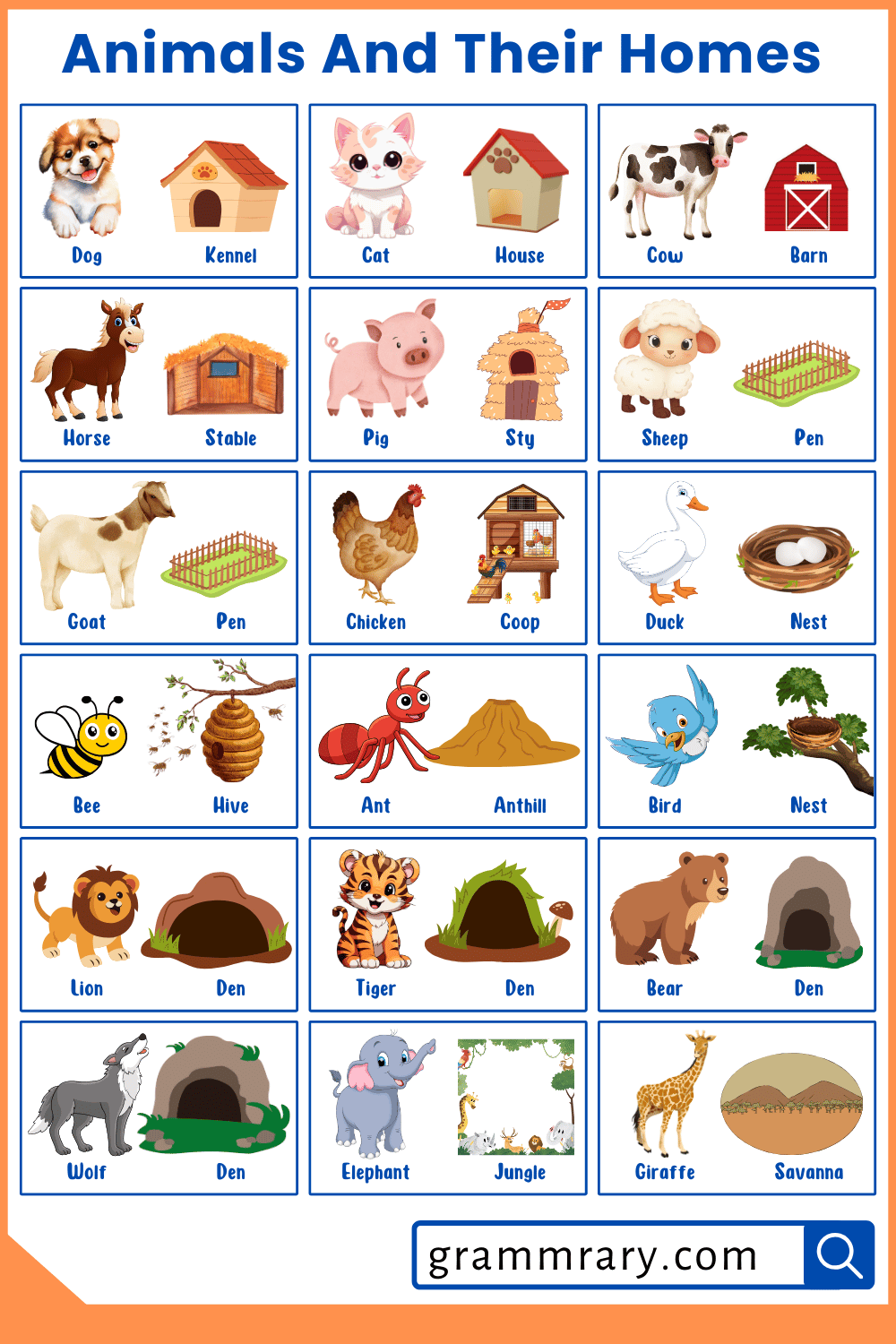
Homes names of Animals in English with Their Pictures
Animals Homes names list in English
- Rabbit – Burrow
- Fox – Den
- Squirrel – Drey
- Mouse – Hole
- Rat – Nest
- Snake – Hole
- Lizard – Rock Crevice
- Frog – Pond
- Fish – Water
- Whale – Ocean
- Dolphin – Ocean
- Shark – Ocean
- Octopus – Den
- Crab – Burrow
- Lobster – Burrow
- Turtle – Shell
- Crocodile – Swamp
- Alligator – Swamp
- Bat – Cave
- Owl – Nest
Different Types of Homes names of Animals with Pictures
- Rabbit – Burrow: A tunnel or hole in the ground, often in fields or forests, where rabbits live and hide.

- Fox – Den: A hidden burrow or cave in the ground, usually in forests or grasslands, where foxes stay and raise their young.

- Squirrel – Drey: A nest made of twigs and leaves, located high in trees, where squirrels live and store food.

- Mouse – Hole: A small hole in walls, fields, or underground where mice live and hide.

- Rat – Hole: A hole built in hidden places like attics, walls, or underground, where rats live and raise their young.

- Snake – Hole: A hole in the ground, often in warm areas, where snakes rest and stay safe.

- Lizard – Rock Crevice: A small gap in rocks, usually in dry or rocky areas, where lizards hide and live.

- Frog – Pond: A small body of water, like a pond or lake, where frogs live, lay eggs, and hunt for food.

- Fish – Water: Fish live in water, whether in rivers, lakes, or oceans, where they swim and find food.

- Whale – Ocean: Whales live in the ocean, where they travel long distances and find food.

- Dolphin – Ocean: Dolphins live in the ocean, where they swim in groups and hunt for fish.

- Shark – Ocean: Sharks live in the ocean, where they are top predators, hunting various sea creatures.

- Octopus – Den: A hidden spot in rocks or coral reefs under the sea, where octopuses live and hide from predators.

- Crab – Burrow: A hole dug into the sand or mud near the beach or riverbanks, where crabs live.

- Lobster – Burrow: A tunnel or hole in the ocean floor, often in rocky areas, where lobsters hide.

- Turtle – Shell: Turtles carry their home on their back—their shell—which protects them wherever they go.

- Crocodile – Swamp: Crocodiles live in swamps or slow-moving rivers, where they hunt and stay cool in the water.

- Alligator – Swamp: Alligators live in swamps and marshes, mostly in the southern United States, where they hunt and bask in the sun.

- Bat – Cave: Bats live in dark caves, where they hang upside down and sleep during the day.

- Owl – Nest: Owls live in nests, often found in tree holes or high up in forests, where they rest and hunt at night.

List of Animals with their Houses names
- Eagle – Eyrie
- Hawk – Eyrie
- Pigeon – Loft
- Peacock – Roost
- Parrot – Cage
- Flamingo – Nest
- Penguin – Rookery
- Ostrich – Nest
- Swan – Nest
- Vulture – Nest
- Goose – Nest
- Duck – Nest
- Sparrow – Nest
- Woodpecker – Tree Hole
- Swallow – Nest
- Raven – Nest
- Crow – Nest
- Magpie – Nest
- Raccoon – Den
- Skunk – Den
Houses Names of Animals and their Pictures
- Eagle – Eyrie: A large nest built high on cliffs or tall trees, where eagles live and raise their young.

- Hawk – Eyrie: Similar to an eagle, a hawk’s eyrie is a nest located on high cliffs or tall trees, providing safety for their chicks.

- Pigeon – Loft: A loft is usually a sheltered space in buildings or rooftops where pigeons live and nest.

- Peacock – Roost: A peacock roosts in trees, especially at night, to stay safe from predators.

- Parrot – Cage: Parrots are often kept in cages, typically indoors, where they are protected and cared for by people.

- Flamingo – Nest: Flamingos build their nests out of mud near water bodies like lakes or lagoons.

- Penguin – Rookery: A rookery is a large colony of penguins, often found on rocky shores or ice, where they nest together.

- Ostrich – Nest: Ostriches lay their eggs in nests on the ground, often in dry, open areas like savannas.

- Swan – Nest: Swans build their nests out of grass and reeds near the water’s edge in lakes or rivers.

- Vulture – Nest: Vultures make their nests in high places like cliffs or tall trees to keep their chicks safe.

- Goose – Nest: Geese nest on the ground, often near water, building their nests out of grass and feathers.

- Duck – Nest: Ducks build nests near water, such as ponds or rivers, where they lay their eggs.

- Sparrow – Nest: Sparrows create small nests out of twigs and grass, usually in trees, bushes, or building eaves.

- Woodpecker – Tree Hole: Woodpeckers create holes in trees where they live and raise their young.

- Swallow – Nest: Swallows build mud nests on the sides of buildings or cliffs, often in colonies.

- Raven – Nest: Ravens make large nests in tall trees or on cliffs, using sticks and twigs.

- Crow – Nest: Crows build their nests in tall trees, using sticks and lined with softer materials.

- Magpie – Nest: Magpies build large, domed nests in trees, often using twigs and mud.

- Raccoon – Den: Raccoons live in dens, which can be found in tree hollows, caves, or even abandoned buildings.

- Skunk – Den: Skunks make dens in burrows, hollow logs, or under porches, where they stay safe and sleep.

Wild animals and their homes names
- Beaver – Lodge
- Otter – Holt
- Seal – Ice Floe
- Walrus – Ice Floe
- Polar Bear – Den
- Grizzly Bear – Den
- Panda – Bamboo Thicket
- Koala – Eucalyptus Tree
- Chimpanzee – Nest
- Gorilla – Nest
- Orangutan – Nest
- Baboon – Tree
- Monkey – Tree
- Lemur – Tree
- Sloth – Tree
- Armadillo – Burrow
- Hedgehog – Burrow
- Porcupine – Den
- Wombat – Burrow
- Meerkat – Burrow
Types of Animals Homes and their names with Pictures
- Beaver – Lodge: A beaver’s lodge is a dome-shaped home made of sticks and mud, built in ponds or rivers to keep them safe and dry.

- Otter – Holt: An otter’s holt is a den or burrow near rivers or lakes, where they sleep and raise their young.

- Seal – Ice Floe: Seals rest and give birth on floating ice floes in polar regions, using them as temporary homes.

- Walrus – Ice Floe: Walruses also use ice floes in the Arctic as places to rest between feeding and caring for their young.

- Polar Bear – Den: Polar bears create dens in snowdrifts or on land in the Arctic, where they give birth and shelter from the cold.

- Grizzly Bear – Den: Grizzly bears dig dens in mountains or forests to hibernate and stay safe during winter.

- Panda – Bamboo Thicket: Pandas live in dense bamboo forests, where they find both food and shelter.

- Koala – Eucalyptus Tree: Koalas live in eucalyptus trees in Australia, where they eat leaves and sleep in the branches.

- Chimpanzee – Nest: Chimpanzees build nests high in trees using leaves and branches, where they sleep at night.

- Gorilla – Nest: Gorillas make nests on the ground or in trees in dense forests, using leaves and twigs to sleep.

- Orangutan – Nest: Orangutans create nests in tall rainforest trees, using branches and leaves as bedding.

- Baboon – Tree: Baboons sleep in trees or on cliffs, using high places to stay safe from predators.

- Monkey – Tree: Monkeys live in trees in forests or jungles, where they find food and avoid ground-based dangers.

- Lemur – Tree: Lemurs live in the trees of Madagascar’s forests, where they leap from branch to branch in search of food.

- Sloth – Tree: Sloths live in trees in tropical rainforests, moving slowly among the branches where they eat and sleep.

- Armadillo – Burrow: Armadillos dig burrows in the ground, often in grasslands or forests, where they sleep and hide.

- Hedgehog – Burrow: Hedgehogs make burrows in gardens, woods, or hedges, where they sleep and stay safe.

- Porcupine – Den: Porcupines find shelter in dens, usually in rock crevices or hollow logs in forests.

- Wombat – Burrow: Wombats dig extensive burrow systems in Australian grasslands or forests, where they sleep and stay cool.

- Meerkat – Burrow: Meerkats live in burrows in desert regions, which provide protection from predators and harsh sunlight.

100 Animals names with their homes names
- Mongoose – Burrow
- Warthog – Burrow
- Deer – Forest
- Moose – Forest
- Elk – Forest
- Caribou – Tundra
- Reindeer – Tundra
- Bison – Plains
- Buffalo – Plains
- Camel – Desert
- Llama – Mountains
- Alpaca – Mountains
- Yak – Mountains
- Ibex – Mountains
- Goat – Mountains
- Sheep – Meadow
- Horse – Stable
- Donkey – Stable
- Mule – Stable
- Pig – Sty
wild Animals names with their homes names with Pictures
- Mongoose – Burrow: Mongooses live in burrows dug in the ground, often in grasslands or forests, where they find safety and raise their young.

- Warthog – Burrow: Warthogs make burrows in savannas or grasslands, using them to sleep and hide from predators.

- Deer – Forest: Deer live in forests, where they find food, shelter, and cover from predators among the trees and undergrowth.

- Moose – Forest: Moose live in northern forests, often near lakes or rivers, where they graze on aquatic plants and shrubs.

- Elk – Forest: Elk live in forested areas, especially in mountainous regions, where they graze on grasses and leaves.

- Caribou – Tundra: Caribou live in the tundra, a cold, treeless region, where they migrate in search of food.

- Reindeer – Tundra: Reindeer also inhabit the tundra, grazing on lichens and other sparse vegetation in cold, northern regions.

- Bison – Plains: Bison live on grassy plains, where they roam in herds and graze on the abundant grass.

- Buffalo – Plains: Buffalo, like bison, live on plains and savannas, grazing on grasses in large herds.

- Camel – Desert: Camels live in deserts, where their homes are vast, arid landscapes with very little vegetation.

- Llama – Mountains: Llamas live in the high mountains of South America, where they are adapted to the rugged terrain and cooler climate.

- Alpaca – Mountains: Alpacas also live in the high Andes Mountains, where they are raised for their soft wool.

- Yak – Mountains: Yaks live in the cold, high-altitude mountains of Central Asia, grazing on grasses and herbs.

- Ibex – Mountains: Ibex live in mountainous regions, where they are adept at climbing steep, rocky slopes to graze.

- Goat – Pen: Mountain goats live on rugged, steep cliffs in mountainous areas, where they graze on grasses and shrubs.

- Sheep – Pen: Sheep live in meadows and grasslands, grazing on grasses and other plants in open fields.

- Horse – Stable: Horses are often kept in stables, which are shelters built on farms or ranches to protect them from the weather.

- Donkey – Stable: Donkeys are housed in stables, similar to horses, where they are cared for and protected from the elements.

- Mule – Stable: Mules are also kept in stables, where they rest and are fed after working on farms or carrying loads.

- Pig – Sty: Pigs live in sties, which are small, fenced enclosures on farms where they are kept safe and well-fed.

Read Also:

